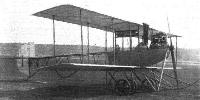
Варианты
- Avro - Type D - 1911 - Великобритания
- Avro - Type E / 500 - 1912 - Великобритания
- Lakes - Sea Bird - 1913 - Великобритания
Avro серии D
Биплан Avro серии D ознаменовал отход Роу от схемы триплана. Было построено шесть самолетов этой серии, и все они отличались друг от друга. Первый поднялся в воздух 1 апреля 1911 года в Бруклендсе, на нем стоял мотор Green мощностью 35 л.с. По мнению нескольких пилотов, летавших на аппарате, он отличался устойчивостью и был прост в управлении. За первые недели полетов на аппарате было предпринято несколько попыток установления рекорда продолжительности полета. Самолет принимал участие в гонках и демонстрировался парламентскому комитету по воздушной обороне. Для испытаний на флотском носителе аэростатов "Гермион" аппарат оснастили поплавками, и 18 ноября 1911 года он впервые в Великобритании выполнил взлет с водной поверхности.
Модернизированный самолет серии D с двигателем ENV мощностью 60 л. с. построили специально для участия в гонках на кубок Британии, организованных в 1911-1914 годах газетой "Daily Mail", однако самолет разбился еще до их начала. Четыре других построенных самолета, по непроверенным данным, были оснащены моторами Green мощностью 45 л.с, Viale мощностью 35 л.с. и Isaacson мощностью 50 л.с. На трех уцелевших самолетах полеты прекратили в мае 1914 года.
ТАКТИКО-ТЕХНИЧЕСКИЕ ХАРАКТЕРИСТИКИ
Avro серии D
Тип: двухместный биплан
Силовая установка: один двигатель Green жидкостного охлаждения мощностью 35 л. с. (26 кВт)
Характеристики: максимальная скорость на уровне моря 78 км/ч
Масса: максимальная взлетная 227 кг.
Размеры: размах крыла 9,45 м; длина 8,53 м; высота 2,79 м; площадь крыльев 28,80 м'
- Avro серии D
Фотографии
-
Мировая Авиация 109
Самолет Type D, созданный в 1911 году, оказался очень удачным. Поплавковый вариант этой машины совершил первый в Британии взлет с воды 18 ноября. Доработанный Type D принимал участие в гонке на приз газеты "Daily Mail".
-
Aviation Historian 15 / P.Jarrett - Mr. Cody & Mr. Roe (2)
The Avro Type D was a significant advance for Roe and heralded the advent of a great line of Avro biplanes. Pilot C. Howard Pixton is at the controls here. Note the extended undercarriage skids to prevent the aircraft nosing over.
-
Flight 1937-05 / Flight
The beginning of real flying may be said to have started with this Avro biplane of 1911. The engine was a 35 h.p. Green. Note the open aft portion of the fuselage.
-
Мировая Авиация 38
Первый полет на самолете серии D в 1911 году выполнил С. Говард Пикстон. Позже летчик на этой же машине летал вместе с ее конструктором.
-
Air-Britain Archive 1983-04
The Shoreham Flying School took over the aeroplanes and sheds of the Avro School at Shoreham in mid-1913. Shown here is an Avro Type D of the Shoreham School with Pashley at the controls, one of the others is Geere.
-
Flight 1930-01 / Flight
Round about 1910, A. V. Roe returned once more to Brooklands, where, backed by the experience gained from his early efforts, he constructed a number of successful machines. One of these, this time a biplane, of 1911, is shown, and it was from this that the famous 504 was developed.
-
Aviation Historian 9 / F.Merriam - Up for the Cup! /Echoes from Dawn Skies/ (4)
The Pashleys’ Henry Farman biplane at Shoreham in 1914, with a Green-engined Avro Type D in the background. The race for the Brighton Cup on July 11 that year included two heats of four laps each and a final of six laps of the 1 3/4-miie (2-8km) course, the winner receiving not only the cup but also ?70, courtesy of Shell.
Другие самолёты на фотографии: Farman Farman-IV - Франция - 1910
-
Aviation Historian 10 / F.Merriam - Birds of a Feather /Echoes from Dawn Skies/ (5)
Frederick Raynham was born in Suffolk on July 15, 1893, and after working with J.V. Neale at Brooklands from late 1909, joined A.V. Roe, also at Brooklands, in 1911. Raynham’s Royal Aero Club Certificate, No 85, carries the same date, May 9, 1911, as that of Ronald Kemp, with whom Raynham later established the Air Survey Co Ltd.
-
Flight 1938-01 / Flight
Early seaplane work: A 1911 biplane with 35 h.p. Green engine, flown by Commander Schwann at Barrow.
Commander Schwann's Avro, the first tractor seaplane to get off the water. In the photo, Sippe is in the cockpit. -
Jane's All the World Aircraft 1980 / Encyclopedia of Aviation - Aircraft A-Z - v2
Avro Type D undergoing trials as a seaplane.
-
Aviation Historian 11 / F.Merriam - Happy but Broke /Echoes from Dawn Skies/ (6)
Sippe at the controls of the Avro Type D seaplane at Cavendish Dock, Barrow-in-Furness, in April 1912. The series of flights Sippe made from the water that month proved the feasibility of marine aircraft. Sippe joined the Royal Naval Air Service in 1914 and participated that November in a famous bombing raid on Friedrichshafen.
-
Air Enthusiast 2007-09 / D.Hobbs - Wait and See /Pioneering days/
Cdr Schwann's Avro Type D inside the airship shed at Barrow, 1911.
-
Flight 1938-01 / Flight
The family tree: These six sketches ot early types show quite clearly the natural evolution which culminated in the 504, the type which laid the foundation of the greatness of the house of Avro
Другие самолёты на фотографии: Avro Avro 504 - Великобритания - 1913Avro Triplane I - III - Великобритания - 1909Avro Triplane IV - Великобритания - 1910Avro Type E / 500 - Великобритания - 1912
- Фотографии












